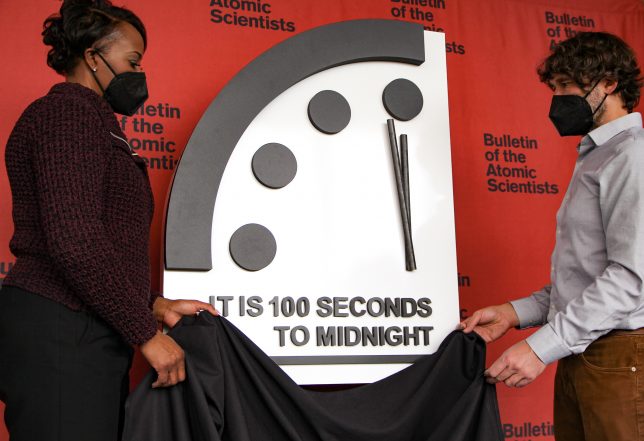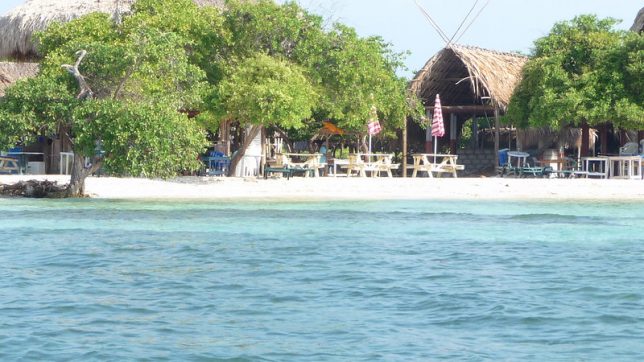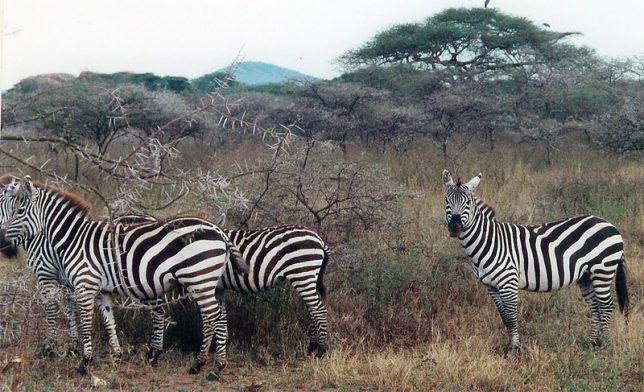
Lack of actionable climate policies, continuing and dangerous threats posed by nuclear weapons, disruptive technologies, insufficient global COVID-19 response, and disinformation lead to a “mixed threat environment.”
On Thursday, January 20, 2022, the 75th anniversary of its Doomsday Clock (“Clock”), the Bulletin of the Atomic Scientists (“Bulletin”) announced that the Clock is set at 100 seconds to midnight, closer to midnight than ever in its history. This marks our second consecutive year with the Clock at 100 seconds to midnight.
The Doomsday Clock is a metaphor for how dangerous this moment is in human history. Since 1947, the Clock has symbolized how close humanity is to destroying itself with nuclear weapons, climate change, and disruptive technologies. The Clock’s time is set by the Bulletin of the Atomic Scientists’ Science and Security Board with the support of the Bulletin’s Board of Sponsors, which includes 11 Nobel Laureates. Designed by painter Martyl Langsdorf, the Clock has become an international symbol of the world’s vulnerability to catastrophe. The Clock symbolizes danger, caution, hope, and our responsibility to one another.
[T]he Clock is not set by signs of good intentions but by evidence of action or, in this case, inaction. Signs of new arms races are clear.
—Scott D. Sagan, Ph.D., Caroline S.G. Munro Professor of Political Science, the Mimi and Peter Haas University Fellow in Undergraduate Education, and Senior Fellow at the Center for International Security and Cooperation (CISAC) and the Freeman Spogli Institute (FSI) at Stanford University, and member, Science and Security Board (SASB), Bulletin of the Atomic Scientists
Stuck in a perilous moment
The Doomsday Clock statement explains that the Clock remains the closest it has ever been to the civilization-ending apocalypse because the world remains stuck in an extremely dangerous moment.”
One hundred seconds to midnight reflects the Board’s judgment that we are stuck in a perilous moment—one that brings neither stability nor security. Positive developments in 2021 failed to counteract negative, long-term trends.
—Sharon Squassoni, co-chair of the Science and Security Board (SASB), Bulletin of the Atomic Scientists, and a research professor at the Institute for International Science and Technology Policy at George Washington University
We have an obligation and opportunity to fix these problems
The Bulletin of the Atomic Scientists was founded in 1945 by Albert Einstein, J. Robert Oppenheimer, Eugene Rabinowitch, and University of Chicago scientists who helped develop the first atomic weapons in the Manhattan Project. The scientists felt that they “could not remain aloof to the consequences of their work” and worked to inform the public and policymakers about manufactured threats to human existence. The Bulletin was founded on the belief that because humans created these problems, we have the obligation and opportunity to fix them.
The Doomsday Clock continues to hover dangerously, reminding us about how much work is needed to be done to ensure a safer and healthier planet. We must continue to push the hands of the Clock away from midnight.
—Rachel Bronson, PhD, president and CEO, Bulletin of the Atomic Scientists
Key recommendations to reverse the hands of the Clock
The 2022 Doomsday Clock statement lists steps to address the current threats. Below are key recommendations to reverse the hands of the Clock:
Climate change
- The United States and other countries should accelerate their decarbonization, matching policies to commitments. China should set an example by pursuing sustainable development pathways – not fossil fuel-intensive projects – in the One Belt One Road initiative.
- Private and public investors need to redirect funds away from fossil fuel projects to climate-friendly investments.
- The world’s wealthier countries need to provide more financial support and technology cooperation to developing countries to undertake strong climate action. COVID-recovery investments must favor climate mitigation and adaptation objectives across all economic sectors and address the full range of potential greenhouse gas emission reductions, including capital investments in urban development, agriculture, transport, heavy industry, buildings and appliances, and electric power.
- At every reasonable opportunity, citizens of all countries must hold their local, regional, and national political officials and business and religious leaders accountable by asking “What are you doing to address climate change?”
Biological risks
- US and other leaders should work through the WHO and other international institutions to reduce biological risks of all kinds through better monitoring of animal-human interactions, improvements in international disease surveillance and reporting, increased production and distribution of medical supplies, and expanded hospital capacity.
- National leaders and international organizations must devise more effective regimes for monitoring biological research and development efforts.
Nuclear weapons
- The Russian and US presidents should identify more ambitious and comprehensive limits on nuclear weapons and delivery systems by the end of 2022. They should both agree to reduce reliance on nuclear weapons by limiting their roles, missions, and platforms, and decrease budgets accordingly.
- The United States should persuade allies and rivals that no-first-use of nuclear weapons is a step toward security and stability and then declare such a policy in concert with Russia (and China).
- President Biden should eliminate the US presidents’ sole authority to launch nuclear weapons and work to persuade other countries with nuclear weapons to put in place similar barriers.
- North Korea should codify its moratorium on nuclear tests and long-range missile tests and help other countries verify a moratorium on enriched uranium and plutonium production.
Disinformation
- Governments, technology firms, academic experts, and media organizations need to cooperate to identify and implement practical and ethical ways to combat internet-enabled misinformation and disinformation.
Other global threats
- Russia should rejoin the NATO-Russia Council and collaborate on risk-reduction and escalation-avoidance measures.
- Iran and the United States must jointly return to full compliance with the Joint Comprehensive Plan of Action and initiate new, broader talks on Middle East security, and missile constraints.
No one changes the world alone. We’re not all going to agree, but we have to work together. And together, we will get it done.
—Hank Green, New York Times best-selling author and science communicator
#TurnBackTheClock
The Bulletin is asking people to take the #TurnBackTheClock Challenge. The challenge encourages people to share their ideas to Instagram, Facebook, YouTube, Twitter, or TikTok using the hashtag #TurnBackTheClock. Share stories and ideas about:
- Positive actions that inspire
- People or groups who are making a difference
- Ways to help make the world safer
The format for submissions can include art, writing, videos, or song.
“We can no longer afford to focus all of our efforts on other perils to the exclusion of the biological threat. If we do, diseases and the lives they take will push the second hand on the Doomsday Clock closer to midnight.”
—Asha M. George, DrPH, executive director, Bipartisan Commission on Biodefense, and member, Science and Security Board (SASB), Bulletin of the Atomic Scientists
Since its inception, the Bulletin’s Doomsday Clock has been set closer and farther away from midnight. In 2020, Bulletin set the Clock the closest it has ever been to midnight 100 seconds. The Clock has been set as far away as 17 minutes to midnight at the end of the Cold War.
In conjunction with the Doomsday Clock’s 75th anniversary, the Bulletin published a new book, The Doomsday Clock at 75, about the history of the Clock and its massive influence on science, politics, pop culture, entertainment, comics, and art.


